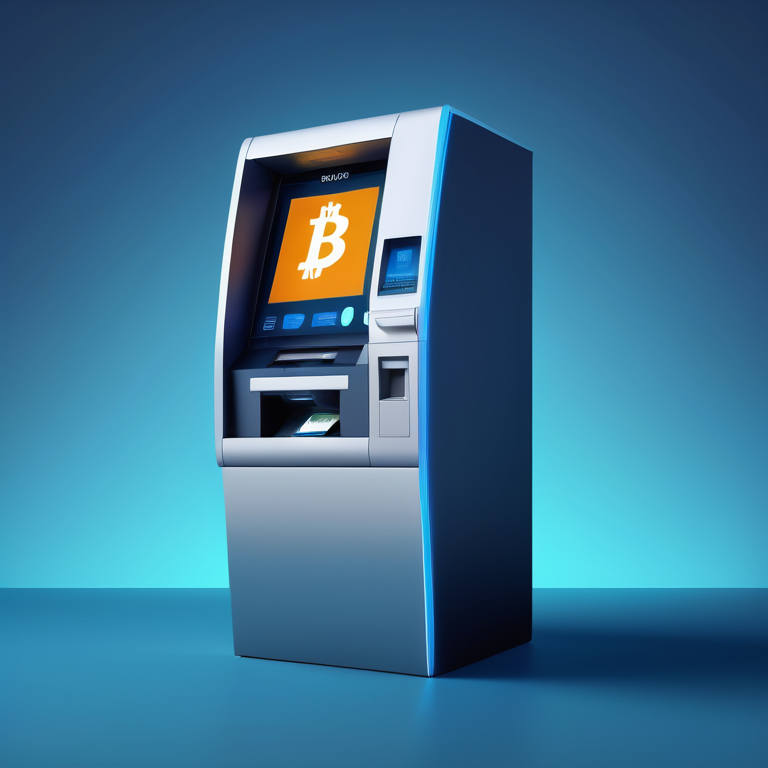How much does a Bitcoin ATM cost?
The price of a Bitcoin ATM can vary depending on various factors such as the machine’s features, brand, and location. On average, a Bitcoin ATM can cost anywhere between $5,000 to $25,000 or more. It is advisable to research different options and compare prices before making a purchase.

https://generalbytes.atlassian.net/wiki/spaces/ESD/pages/1002537037
https://generalbytes.atlassian.net/wiki/spaces/ESD/pages/1638367271/Hot+Wallet+CryptX+Wallet+System
https://coinatmradar.com/charts/growth/
https://www.statista.com/statistics/343147/number-of-bitcoin-atms-countries/
https://branch.wallet.bitcoin.com/pZhP3KumqAb
https://www.instagram.com/crypto.dispensers/
Understanding Bitcoin and its ATMs
Bitcoin, also known as cryptocurrency, operates on a decentralized ledger called a blockchain. Bitcoin ATMs enable users to buy or sell Bitcoin for fiat currency securely through a digital wallet. These transactions are then verified and recorded on the blockchain. This process ensures the security and transparency of cryptocurrency exchanges. Users can conveniently conduct transactions using standard ATMs, leveraging debit or credit cards. BTMs need to be connected to the internet to power the exchange of cryptocurrency for cash. Bitcoin ATMs also often require a verification process, especially when transacting large amounts.
Brief Overview of Bitcoin
Bitcoin, as a digital currency, facilitates peer-to-peer transactions independent of a central bank. Transactions, irreversible and secure, are verified by network nodes through cryptography. It can be used for various online and offline purchases, offering a decentralized alternative to traditional currency systems. This digital currency operates on a blockchain, ensuring secure and transparent transactions.
Role and Function of Bitcoin ATMs
Bitcoin ATMs offer a seamless and convenient way for users to engage in cryptocurrency transactions. With the ability to buy and sell Bitcoin, users can deposit cash or credit their digital wallet at these kiosks. These machines provide a user-friendly interface, making cryptocurrency transactions simple and accessible. Additionally, it’s important to note that Bitcoin ATM fees and exchange rates may vary across different machines, offering users flexibility in their transaction choices.
Types of Bitcoin ATMs and Their Operational Mechanisms
Bitcoin ATMs come in two primary types: unidirectional and bidirectional, providing convenience for buying or selling transactions. These operational mechanisms involve a QR code scan, digital wallet integration, and currency exchange. With these features, users can seamlessly convert digital cryptocurrency into fiat currency without the need for cryptocurrency exchanges. Offering a user-friendly interface, bitcoin ATMs facilitate transactions using debit or credit cards, making it easy to access both USD and BTC.
Exploring the Different Types of Bitcoin ATMs
Bitcoin ATMs come in various types to cater to different user needs. Unidirectional ATMs primarily support one-way transactions, while bidirectional ATMs enable users to conduct two-way transactions. These machines offer a simple interface for users to navigate, making it easy to buy or sell Bitcoin. Operators may choose a specific type based on customer demand, ensuring that users have a smooth experience when using cryptocurrency exchanges and Bitcoin wallets.
How Bitcoin ATMs Work
Bitcoin ATMs enable seamless transactions with a digital wallet and cash deposit, initiated by scanning a QR code or through a secure connection to your account via phone number. These machines calculate exchange rates for Bitcoin transactions and display transaction fees beforehand. Providing a convenient way to access digital currency, they offer a user-friendly interface for cryptocurrency exchanges. Users can easily navigate the options for buying or selling Bitcoin using standard ATMs. Additionally, Bitcoin ATMs display exchange rates in both USD and BTC, allowing users to make informed decisions before completing transactions.
The Growth and Business Model of Bitcoin ATMs
Bitcoin ATMs have seen exponential growth worldwide, expanding their networks to meet the increasing demand for Bitcoin transactions. The business model revolves around generating revenue from transaction fees and exchange rate markups. Additionally, operators are continually adapting to technological advancements, and the business model includes aspects such as compliance, customer support, and machine maintenance, ensuring seamless and secure transactions. As the market for cryptocurrency exchanges evolves, bitcoin ATMs continue to play a pivotal role in facilitating easy access to digital currencies.
The Rise and Expansion of Bitcoin ATMs
The widespread installation of Bitcoin ATMs globally signifies the growing acceptance and adoption of cryptocurrencies. These ATMs are strategically placed in high-traffic locations, catering to a diverse customer base that includes crypto enthusiasts and investors. The rise of Bitcoin ATMs is further fueled by enhanced features like biometric verification, contributing to their increased accessibility and functionality. This expansion reflects the evolving landscape of cryptocurrency exchanges, offering convenient access to digital currency for users through standard ATMs.
The Business Model Behind Bitcoin ATMs
Bitcoin ATMs generate revenue through transaction fees and exchange rate markups, integrating digital currency transactions with traditional financial services. Operators prioritize compliance with regulatory requirements such as KYC and AML to ensure legality. Customer support and service are vital for sustaining a successful business model. Innovations in Bitcoin ATM technology drive operational efficiency and customer satisfaction while catering to the diverse needs of cryptocurrency enthusiasts and investors.
Cost Considerations for Starting an ATM Business
Factors impacting the expenses of launching an ATM enterprise encompass the buying, installment, and upkeep of the machine. Operators need to consider the costs related to regulatory compliance and day-to-day operations. The profitability of a Bitcoin ATM business relies on transaction volumes and fee configurations. Investing in a Bitcoin ATM business aligns with the transforming arena of digital currency. Cost considerations also involve security measures, software updates, and network connectivity.
Estimated Costs for Setting Up a Bitcoin ATM
Setting up a bitcoin ATM typically incurs an initial cost ranging from $8,000 to $10,000. Additionally, annual maintenance expenses fall between $1,000 and $2,000. Rental costs for the space can vary based on location and foot traffic. The initial investment includes purchasing the Bitcoin machine, software, and compliance expenses. Estimating the overall setup cost involves considering factors such as machine type, location, and regulatory compliance. Operators must also incorporate cryptocurrency exchanges to ensure smooth transactions. Interestingly, the Bitcovault BTC ATM is a top-of-the-line Bitcoin machine that offers flexibility and reliability through its software services.
Potential Earnings and Commissions from a Bitcoin ATM
Operating a Bitcoin ATM business involves potential earnings and commissions influenced by transaction fees, machine usage, and customer demand. The average transaction fee ranges from 8% to 10%, with profitability depending on transaction volume and location. Commissions primarily derive from transaction fees and the revenue potential hinges on factors like transaction frequency and machine accessibility. Maximizing earnings also requires considering cryptocurrency exchanges, bitcoin wallets, and standard ATMs, and optimizing the utilization of debit cards and credit cards.
Navigating Legal Regulations Around Bitcoin ATMs
Understanding the legal requirements is crucial before delving into the realm of a Bitcoin ATM business. Compliance with AML (Anti-Money Laundering) and KYC (Know Your Customer) regulations is paramount for operating within the legal framework. Navigating through local, state, and federal laws and regulations is essential. It involves obtaining relevant licenses, permits, and approvals to ensure regulatory compliance. An understanding of legal obligations is indispensable for the seamless operation of a Bitcoin ATM business.
Understanding Legal Aspects of Operating Bitcoin ATMs
Compliance with financial and security regulations is crucial when operating a Bitcoin ATM business. Adhering to AML (Anti-Money Laundering) laws and ensuring customer identification are pivotal legal considerations. Moreover, understanding regulatory obligations, and responsibilities, and implementing robust security measures are necessary for seamless operation. Transaction transparency and monitoring are also essential to meet legal requirements.
Importance of a Suitable Bank Account for a Bitcoin ATM Business
Establishing a dedicated bank account is critical for a Bitcoin ATM business, enabling seamless cash management and transaction settlements. When choosing a bank account, it’s essential to assess fees, transaction limits, and support. Access to funds, wire transfers, and currency exchange services are vital considerations. Opting for a bank account compatible with Bitcoin ATM operations streamlines financial transactions and reporting, ensuring a smooth operational process.
Optimizing Location for Bitcoin ATMs
Optimizing the placement of Bitcoin ATMs is crucial for their success. This involves evaluating foot traffic, accessibility, and security to identify high-traffic areas and demographic suitability. Strategic placement includes analyzing proximity to retail establishments, transportation hubs, and financial institutions. Maximizing visibility and accessibility at chosen locations is essential for customer convenience.
Factors to Consider When Choosing a Location for Your Bitcoin ATM
When selecting a location for your Bitcoin ATM, evaluating foot traffic, demographics, and nearby businesses is crucial. Accessibility, parking, and security also play a pivotal role. Proximity to banking facilities, retail outlets, and popular destinations influences the choice of a Bitcoin ATM location. Identifying high-demand areas and customer convenience aids in selecting an optimal location. Analyzing customer behavior, spending patterns, and transaction preferences assists in pinpointing a strategic location.
Advantages of Strategically Placed Bitcoin ATMs
Enhancing customer accessibility and convenience, strategically placed Bitcoin ATMs optimize transaction volume and engagement. Visibility and usage increase in high-traffic areas, catering to diverse customer needs and preferences. Easy access to cryptocurrency exchanges fosters satisfaction and loyalty.
Dealing with Bitcoin ATM Fees
Understanding the breakdown of fees associated with cryptocurrency exchanges at Bitcoin ATMs is crucial for both operators and customers. Transparent disclosure of these fees is pivotal for ensuring customer satisfaction and trust. Balancing transaction fees, exchange rates, and customer convenience is essential for running a successful Bitcoin ATM business. Managing and optimizing these fees requires a customer-centric approach and competitive pricing strategies. Offering a comprehensive breakdown of Bitcoin ATM fees fosters transparency and builds confidence among customers. Marketing the ATMs is another crucial expense, involving investment in digital advertising across platforms like Google Ads, Facebook, Twitter, and LinkedIn, and specialized listings like Coinatmradar and Apple Maps.
Comprehensive Breakdown of Bitcoin ATM Fees
Bitcoin ATM fees encompass transaction fees, exchange rate markups, and operational costs. Transaction fees typically range from 6% to 12% of the transaction amount. Exchange rate markups can vary based on market conditions and operator policies. Additional fees such as network fees and service charges may also apply to transactions. Understanding this comprehensive breakdown is crucial for informed decision-making and customer satisfaction.
Understanding the Difference Between Exchange Fees and Wallet Transfer Fees
When engaging in cryptocurrency exchanges, it’s crucial to comprehend the distinction between exchange fees and wallet transfer fees. Exchange fees pertain to the cost of buying or selling Bitcoin on an exchange platform, which can range from 0.1% to 5%. Conversely, wallet transfer fees hinge on Bitcoin network transaction fees that fluctuate based on network usage. It’s imperative to consider both fees when utilizing a Bitcoin ATM for transactions. Understanding these nuances ensures informed decision-making and effective cost management.
Are Bitcoin ATMs a Gateway for Crypto Beginners?
Bitcoin ATMs can serve as a convenient entry point for crypto beginners. They allow users to buy and sell cryptocurrency with cash, providing an accessible way to get started. However, it’s important to note that fees at Bitcoin ATMs can be higher compared to traditional exchanges. Additionally, the range of available cryptocurrencies may be limited.
Conclusion
In conclusion, Bitcoin ATMs provide a convenient and accessible way for users to buy and sell Bitcoin. With various types of Bitcoin ATMs available, it is important to understand their operational mechanisms and cost considerations before starting an ATM business. Navigating the legal regulations and optimizing the location of your Bitcoin ATM are also crucial factors to consider. Additionally, understanding the fees associated with Bitcoin ATMs and their role in introducing beginners to the world of cryptocurrency is essential. Overall, Bitcoin ATMs play a significant role in the growth and adoption of Bitcoin, providing users with a seamless and secure way to transact.




